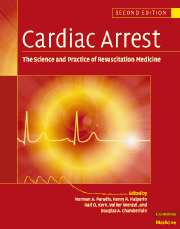Book contents
- Frontmatter
- Contents
- List of contributors
- Foreword
- Preface
- Part I Introduction
- Part II Basic science
- 3 Global cellular ischemia/reperfusion during cardiac arrest: critical stress responses and the postresuscitation syndrome
- 4 Genetics, genomics and proteomics in sudden cardiac death
- 5 Intracellular signaling during myocardial ischemia
- 6 Electrophysiology of ventricular fibrillation and defibrillation
- 7 The neuroendocrine response to global ischemia and reperfusion
- 8 Inflammatory and Immunologic responses to ischemia and reperfusion
- 9 Methodology of laboratory resuscitation research
- 10 The methodology of clinical resuscitation research
- 11 The special problem of consent for resuscitation research
- Part III The pathophysiology of global ischemia and reperfusion
- Part IV Therapy of sudden death
- Part V Postresuscitation disease and its care
- Part VI Special resuscitation circumstances
- Part VII Special issues in resuscitation
- Index
6 - Electrophysiology of ventricular fibrillation and defibrillation
from Part II - Basic science
Published online by Cambridge University Press: 06 January 2010
- Frontmatter
- Contents
- List of contributors
- Foreword
- Preface
- Part I Introduction
- Part II Basic science
- 3 Global cellular ischemia/reperfusion during cardiac arrest: critical stress responses and the postresuscitation syndrome
- 4 Genetics, genomics and proteomics in sudden cardiac death
- 5 Intracellular signaling during myocardial ischemia
- 6 Electrophysiology of ventricular fibrillation and defibrillation
- 7 The neuroendocrine response to global ischemia and reperfusion
- 8 Inflammatory and Immunologic responses to ischemia and reperfusion
- 9 Methodology of laboratory resuscitation research
- 10 The methodology of clinical resuscitation research
- 11 The special problem of consent for resuscitation research
- Part III The pathophysiology of global ischemia and reperfusion
- Part IV Therapy of sudden death
- Part V Postresuscitation disease and its care
- Part VI Special resuscitation circumstances
- Part VII Special issues in resuscitation
- Index
Summary
Introduction
Sudden cardiac death remains a major public health problem in the United States. Despite extensive study and effective treatments for malignant ventricular arrhythmias more than a quarter of a million people die suddenly each year in this country. Sudden death accounts for more than half of all deaths related to cardiovascular disease, coronary artery disease is the most common pathological condition found in patients who die suddenly, and ventricular fibrillation is the most common immediate cause of death.
In the last decade a decline in the incidence of out-ofhospital ventricular fibrillation and a measurable improvement in the long-term survival of patients who have been resuscitated have been documented in the most wellstudied communities. Despite these gains and perhaps because of the changing etiology of cardiac arrest, the overall survival of cardiac arrest victims has not changed in the past two decades.3 In communities with the most sophisticated emergency medical services, the maximal survival rate for out-of-hospital ventricular fibrillation is about 30%. Understanding the mechanism of ventricular fibrillation is critical to making a meaningful impact on the incidence of this arrhythmia and improving the survival of sudden death victims.
Ventricular fibrillation was described by Ludwig and Hoffa in 1849 as an incoordinate heart action that produced a high metabolic rate of the myocardium but no useful contractions.6 The hemodynamic consequences of the disordered cardiac contraction and the fundamental electrophysiologic basis of ventricular fibrillation were understood by the turn of the century. Porter, in 1898, stated that the essential nature of fibrillatory contractions is the result of abnormalities in impulse conduction.
- Type
- Chapter
- Information
- Cardiac ArrestThe Science and Practice of Resuscitation Medicine, pp. 101 - 127Publisher: Cambridge University PressPrint publication year: 2007



